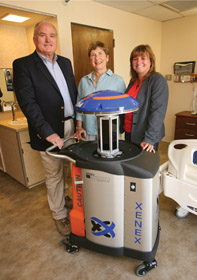Germ Free
 In an effort to eliminate bacteria, viruses, mold and other pathogens from surfaces in patient areas, Sonoma Valley Hospital has become the first hospital in the North Bay to acquire the Xenex Germ-Zapping Robot. This state-of-the-art disinfection device enhances patient safety through an environmentally friendly technology that uses pulsed xenon ultraviolet light (UV) for a 99.9 percent reduction of all major classes of microorganisms that can cause hospital-acquired infection (HAI).
In an effort to eliminate bacteria, viruses, mold and other pathogens from surfaces in patient areas, Sonoma Valley Hospital has become the first hospital in the North Bay to acquire the Xenex Germ-Zapping Robot. This state-of-the-art disinfection device enhances patient safety through an environmentally friendly technology that uses pulsed xenon ultraviolet light (UV) for a 99.9 percent reduction of all major classes of microorganisms that can cause hospital-acquired infection (HAI).“This is another example of our commitment to the highest standards in patient safety and care,” says CEO Kelly Mather, who also notes the hospital was named one of the 15 safest in the country by Consumer Reports earlier this year. “It lets us add another layer of protection for our patients with its disinfection technology, which has been shown to be 20 times more effective than cleaning with chemicals alone.”
The robot, which has been affectionately named Lisa, employs Xenex’s proprietary pulsed xenon UV disinfection technology to quickly reduce germ loads, a major continuing source of concern for every hospital in the country. While not intended as a substitute for the excellent sanitation procedures at the hospital, Mather says it’s expected to reduce costs and improve sanitation efficiency.
Strange But True
Q. If pain has a good side, can you say what it might be?
A. Physiologically speaking, without pain, we might not realize when situations are injurious, leading to greater risk or failure to seek needed medical attention. Yet recently, Peter Salmon of the University of Liverpool, United Kingdom, found that 10 to 20 percent of people he studied had “no obvious link between pain symptoms and underlying disease,” says Simon Ings of New Scientist magazine, reporting on Joanne Bourke’s The Story of Pain: From Prayer to Painkillers. Paradoxically, pain can also involve pleasure, even ecstasy. “And to get rid of pain would be to get rid of sensation altogether.”
Rather, Bourke argues, this humanly universal experience helps bind us all together: “We witness other people’s pain, imagine it, try to salve it. We use it as a measure by which to gauge our own capacity for kindness. It renders us incoherent, yet at the same time prompts us to communicate with each other”—the root of our humanity.
As Ings summarizes the book’s larger point: “Pain is a condition of existence. We can—and absolutely should—attempt to elude, manage and subdue it. But we cannot eliminate it.”
Source: Bill Sones and Rich Sones, Ph.D.



